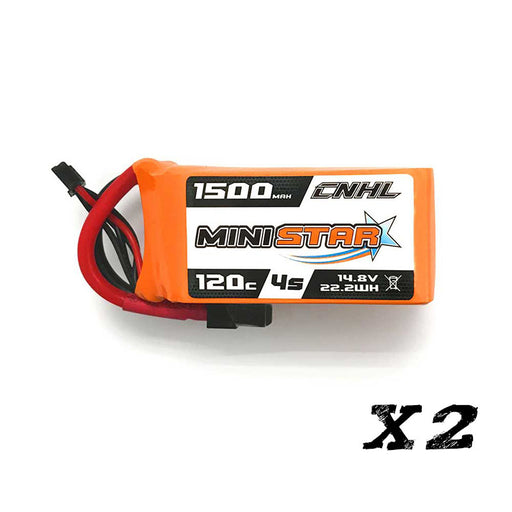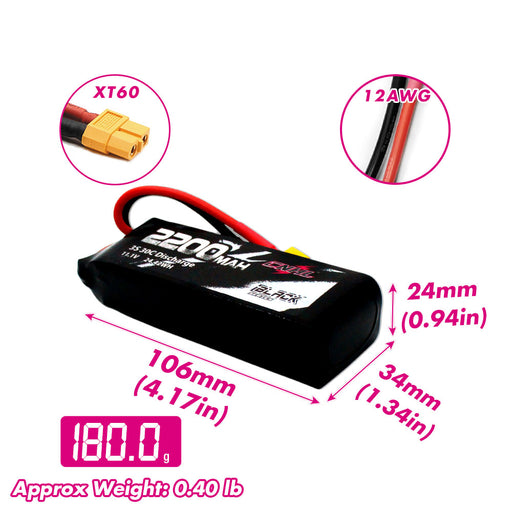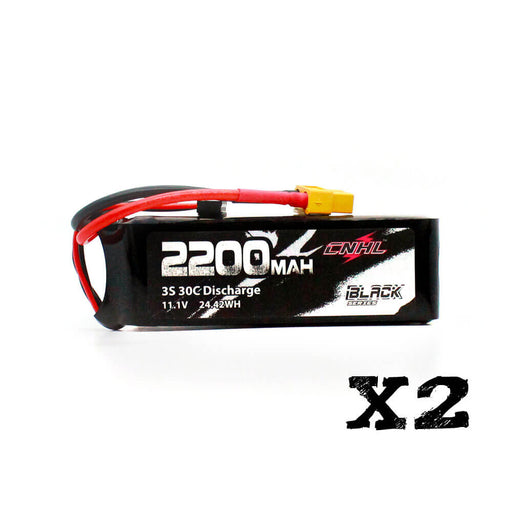
LiPo 배터리의 기본 이해
취미에 처음 입문했든 오랫동안 해왔든 LiPo 배터리에 대해 확실한 한 가지는 많은 정보가 있다는 것입니다. 그중 일부는 훌륭하지만, 일부는 그렇지 않아서 제가 알고 있는 LiPo 배터리와 그것을 다루는 방법에 대해 조금 이야기하는 블로그를 작성해 보았습니다.
이 블로그는 표준 LiPo 배터리에 초점을 맞추고 있으며, 고전압 옵션도 있지만 이 블로그의 범위를 벗어납니다.
LiPo는 방전 곡선 동안 전압을 잘 유지하기 때문에 라디오 제어에 매우 적합합니다. Battery University에서 가져온 이 작은 그래프는 왼쪽에 약 4.2의 시작 전압과 오른쪽에 약 3.3의 차단 전압을 보여줍니다.

방전 곡선에서 볼 수 있듯이 전압은 시작부터 끝까지 약 1볼트 정도만 변동하여 매우 안정적입니다. 전력 전달에 대해 이야기할 때 전압에 전류를 곱하면 와트가 되기 때문에, LiPo는 방전 곡선 동안 전압을 잘 유지합니다.
LiPos는 수요가 매우 높아서 거의 모든 취미 상점에서 쉽게 구할 수 있습니다. 불행히도 LiPo에 관한 정보 중 제가 본 것들은 잘못된 내용이 많습니다. 잘 작성된 문서 중에도 완전히 틀린 것이 있고, 포럼에서 본 정보도 틀린 경우가 많으며, 문제가 될 수 있는 오래된 조언도 있습니다. 심지어 병렬 충전을 완전히 반대하는 사람들도 있는데, 이는 터무니없습니다. 왜냐하면 이 배터리의 절반은 어쨌든 병렬 형식으로 나오기 때문입니다. 결국 누구를 믿을지 결정하는 것은 여러분에게 달려 있습니다.
개인적으로 저는 Battery University에서 정보를 얻는 것을 선호하는데, 그들이 게시하는 모든 정보는 어떤 형태로든 연구에 기반한 정보이기 때문입니다. 보통 회사나 대학에서 게시하며, 데이터를 제시할 때 적어도 과학적 방법을 사용하려고 노력합니다.
Lipo 배터리에 관해서는 이해해야 할 특정 숫자들이 있습니다.
최고 전압부터 시작해 보겠습니다. Lipo 배터리의 최고 전압은 셀당 4.2볼트입니다. 따라서 셀당 4.2볼트 이상으로 충전해서는 안 됩니다.
다음으로 이해해야 할 숫자는 최소 전압입니다. 그 숫자는 셀당 3볼트입니다. 이 숫자 아래로 내려가면 셀에 영구적인 손상을 초래할 것입니다.
안전한 전압은 셀당 3.3볼트로 간주됩니다. 비록 여기서 논쟁이 시작되겠지만, 비행기나 쿼드콥터, 드론 등 어떤 것을 비행하거나 운전할 때 셀당 3.3볼트에서 착륙하면 셀당 3볼트의 손상 수준 아래로 절대 내려가지 않는다는 생각입니다. 저에게 실용적인 부하 전압 최소치는 셀당 3.5볼트이며, 이는 비행할 때 절대 3.5볼트 이하로 내려가지 않으려 한다는 뜻입니다. 그 이유는 셀당 3.5볼트에 도달하면 배터리 출력에서 그 차이를 느낄 수 있기 때문입니다.
비행 중에는 부하가 걸리면 전압이 떨어지는 것을 보게 되며, 부하를 제거하면 셀이 반등합니다. 그래서 저는 약 셀당 3.7볼트 무부하. S비행기에서 비행 라인에서 이륙시켜 벤치에 올리고 배터리를 빼면, 1~2분 후에 셀당 전압이 약 3.75로 다시 올라와야 한다고 기대합니다. 이 값은 보관 전압 범위의 하한선이기도 합니다. 보관 전압은 제가 자주 논쟁을 보는 또 다른 영역입니다. 저는 3.75에서 3.85 사이가 완벽하게 허용된다고 믿습니다. Battery University에 따르면 셀당 약 4.0볼트 이하에서는 사실상 자기 방전이 없으며, 40%에서 50% 충전 상태를 정확히 찾는 것은 그리 중요하지 않다고 합니다. 그래서 저에게는 저장 전압 어딘가 셀당 3.75에서 3.85볼트 사이가 완벽합니다.
Lipo 배터리와 관련하여 또 하나 자주 언급되는 숫자는 공칭 전압입니다. Lipo 셀의 공칭 또는 평균 전압은 3.7볼트이며, 이 숫자는 셀 수에 곱하여 팩 전압을 계산할 때 사용됩니다. 예를 들어 3s 배터리의 경우 3.7 곱하기 3은 11.1이므로 11.1은 팩 전압으로 알려져 있고, 12.6은 최대 전압으로 셀당 4.2볼트 곱하기 3 셀입니다. 이 표의 나머지 부분은 4s 및 6s LiPo 배터리의 공칭 팩 전압과 최대 전압을 보여줍니다.

최대 전압에 관해서는 스웨덴 Chalmers 공과대학의 연구를 언급하고 싶습니다. 모두가 알다시피 4.2볼트는 Lipo 팩의 정상 최대 전압입니다. 최대 전압을 4.2에서 4.15로 낮추면 이 연구는 Lipo 배터리의 사이클 수명이 50%에서 100%까지 증가한다고 밝혔습니다. 최대 전압을 셀당 4.1볼트로 더 낮추면 사이클 수명이 2배로 증가합니다.
핵심 숫자를 다시 정리해 봅시다
- 최대 전압은 셀당 4.2볼트이지만, 최대 전압을 4.2에서 4.15 또는 더 나아가 4.10으로 낮추면 배터리의 사이클 수명을 늘릴 수 있습니다.
- LiPo 셀에 손상을 주기 전 최소 전압은 3.0볼트입니다.
- 널리 인정되는 최소 안전 전압은 3.3볼트이며, 제 경우 실제 부하 방전 전압은 셀당 3.5볼트입니다. 부하가 없는 전압은 셀당 약 3.75볼트 정도여야 하며, 저장 전압은 셀당 3.75에서 3.85볼트 사이가 안전합니다. Lipo 배터리의 공칭 전압은 셀당 3.7볼트이며, 이는 팩 전압 계산에 사용됩니다.
Ne다음은 배터리 표시입니다
Lipo 배터리를 처음 접할 때 이 모든 숫자가 무엇을 의미하는지 이해하는 것은 정말 혼란스러울 수 있습니다. 그래서 간단히 설명해 보겠습니다.
우리는 큰 숫자 4부터 시작할 텐데, 이는 단순히 4 암페어시를 의미합니다. 여기 4000도 보이는데, 이는 암페어시를 1,000배 한 것이므로 4000 밀리암페어시 배터리입니다. 이것이 가스 탱크 크기를 나타내는 참조로, 이 배터리에 얼마나 많은 에너지가 들어 있는지 또는 이 배터리가 얼마나 많은 에너지를 저장할 수 있는지를 말합니다. 따라서 더 많은 mAh는 더 많은 에너지를 저장할 수 있다는 뜻입니다.

다음으로 이야기할 숫자는 방전율입니다. 더 진행하기 전에, 이 숫자들이 과장된 것으로 널리 알려져 있습니다. 대부분 제조사는 배터리에 가장 최적의 조건에서 C 등급을 부풀립니다. 이 숫자는 배터리가 일정 상태와 순간 상태에서 얼마나 많은 전류를 공급할 수 있는지를 나타냅니다. 예를 들어, 암페어시 4에 연속 전류율 30을 곱하면 120암페어의 연속 전류가 됩니다. 이 표시는 이 배터리가 120암페어를 지속적으로 공급할 수 있음을 의미합니다. 40은 약 30초를 넘지 않는 순간적으로 유지할 수 있는 암페어 수를 의미하며, 4 곱하기 40은 160으로, 약 30초 동안 160암페어를 유지할 수 있음을 뜻합니다.
마지막으로 지적할 숫자는 5셀 배터리로 표시되어 있다는 점입니다. 앞서 셀당 공칭 전압이 3.7볼트라고 했던 것을 기억하세요? 3.7에 5를 곱하면 공칭 팩 전압이 18.5볼트가 됩니다. 이것이 바로 거의 모든 시중 리포 배터리에 표시된 내용입니다.
리포 배터리 충전에 관해서는
항상 밸런스 충전기만 사용해야 하며, 셀 밸런싱 기능이 없는 리포 배터리용 충전기는 절대 사용하지 마세요. 옆면을 보면 밸런스 충전기인지 알 수 있는데, 흰색 커넥터용 핀 배열이 있고, 배터리의 메인 리드용 메인 포트도 여기 있습니다.

제품 설명에서 밸런스 충전기라고 말하는 것 외에도, 또 다른 방법으로 알 수 있습니다.
충전 화면을 보면 알 수 있는데, 이 경우 5셀 배터리가 연결되어 있고 5개 셀 각각의 전압을 볼 수 있습니다. 3.8 /3.8 /3.8 /3.8/ 3.8.

마지막으로 관리 및 취급에 관해서입니다.
이것은 또 다른 논쟁의 여지가 있는 부분이 될 것이지만, 저에게는 효과가 있었습니다. 그래서 계속 그렇게 할 것입니다. 저는 항상 이 배터리들의 내부 저항을 측정할 수 있는 배터리 충전기를 사용합니다. 소비자용 기기에서는 매우 정확하거나 신뢰할 만하다고 여겨지지 않지만, 제가 아는 것은 내부 저항 테스트를 할 때, 세미 배터리에서 저항 값이 74 이상이면 배터리를 퇴역시킨다는 것입니다. 시간이 지나면서 저에게는 효과가 있었기에 계속 그렇게 할 것입니다. 여러분은 자신을 행복하게 하는 대로 하세요. 저에게는 내부 저항 값이 7 이상이면 그 배터리는 선반에 올려둡니다.

베스트 셀러즈
-
원래 가격 $65.99원래 가격 $65.99 - 원래 가격 $65.99원래 가격 $65.99$54.99 USD - $65.99 USD$54.99 - $65.99현재 가격 $54.99 USD
CNHL G+Plus 5000mAh 22.2V 6S 리포 배터리 70C EC5 플러그 포함
재고 10+개 이상 있습니다사양: 재고 번호: 500706EC5 용량: 5000mAh 전압: 22.2V / 6-셀 / 6S1P 방전율: 70C 연속 / 140C 순간 충전율: 최대 5C 크기(1-5mm 차이): 49X51X149mm(높이*너비*길이) 대략 무게(±5g) : 714g 출...
전체 세부 정보 보기원래 가격 $65.99원래 가격 $65.99 - 원래 가격 $65.99원래 가격 $65.99$54.99 USD - $65.99 USD$54.99 - $65.99현재 가격 $54.99 USD최대 17% 절약하세요 -
원래 가격 $38.99원래 가격 $38.99 - 원래 가격 $38.99원래 가격 $38.99$34.99 USD - $38.99 USD$34.99 - $38.99현재 가격 $34.99 USD
CNHL 스피디 피자 시리즈 프로 1350mAh 22.2V 6S 150C 리포 배터리 XT60 플러그 포함
재고 10+개 이상 있습니다사양: 재고 번호: 1351506PZ 용량: 1350mAh 전압: 22.2V / 6셀 / 6S1P 방전 속도: 연속 150C / 순간 300C 충전 속도: 최대 5C 크기(1-5mm 차이): 38X38X78mm 대략 무게(±5g) : 215g 출력 커넥터: X...
전체 세부 정보 보기원래 가격 $38.99원래 가격 $38.99 - 원래 가격 $38.99원래 가격 $38.99$34.99 USD - $38.99 USD$34.99 - $38.99현재 가격 $34.99 USD최대 10% 절약하세요 -
원래 가격 $51.98원래 가격 $51.98 - 원래 가격 $51.98원래 가격 $51.98$45.98 USD - $51.98 USD$45.98 - $51.98현재 가격 $45.98 USD
2팩 CNHL 블랙 시리즈 V2.0 1300mAh 22.2V 6S 130C 리포 배터리 XT60 플러그 포함
재고 10+개 이상 있습니다사양 재고 번호: 1301306BK 용량: 1300mAh 전압: 22.2V / 6-셀 / 6S1P 방전율: 130C 연속 / 260C 순간 충전율: 최대 5C 크기(1-5mm 차이): 48X33X77mm 대략 무게(±5g) : 210g 출력 커넥터: XT60 밸...
전체 세부 정보 보기원래 가격 $51.98원래 가격 $51.98 - 원래 가격 $51.98원래 가격 $51.98$45.98 USD - $51.98 USD$45.98 - $51.98현재 가격 $45.98 USD최대 12% 절약하세요 -
원래 가격 $43.98 - 원래 가격 $43.98원래 가격 $43.98$43.98 USD$43.98 - $43.98현재 가격 $43.98 USD
[Combo] 2팩 CNHL MiniStar 1500mAh 14.8V 4S Lipo 배터리 120C XT60 플러그 포함
재고 10+개 이상 있습니다사양: 재고 번호: 1501204 용량: 1500mAh 전압: 14.8V / 4셀 / 4S1P 방전 속도: 연속 120C / 순간 240C 충전 속도: 최대 5C 크기(1-5mm 차이): 37X33X76mm 대략 무게(±5g) : 169g 출력 커넥터: XT60...
전체 세부 정보 보기원래 가격 $43.98 - 원래 가격 $43.98원래 가격 $43.98$43.98 USD$43.98 - $43.98현재 가격 $43.98 USD -
원래 가격 $23.98 - 원래 가격 $37.98원래 가격 $23.98 - 원래 가격 $37.98원래 가격 $23.98$19.98 USD - $37.98 USD$19.98 - $37.98현재 가격 $19.98 USD
2팩 CNHL 블랙 시리즈 2200mAh 3S 11.1V 30C 리포 배터리 XT60 플러그 포함
재고 10+개 이상 있습니다사양: 재고 번호: 220303BK 용량: 2200mAh 전압: 11.1V / 3셀 / 3S1P 방전율: 30C 연속 / 60C 버스트 충전 속도: 최대 5C 크기(1-5mm 차이): 24X34X106mm 대략 무게(±5g) : 180g 출력 커넥터: XT60 ...
전체 세부 정보 보기원래 가격 $23.98 - 원래 가격 $37.98원래 가격 $23.98 - 원래 가격 $37.98원래 가격 $23.98$19.98 USD - $37.98 USD$19.98 - $37.98현재 가격 $19.98 USD최대 17% 절약하세요
새 항목
-
원래 가격 $122.99 - 원래 가격 $122.99원래 가격 $122.99$122.99 USD$122.99 - $122.99현재 가격 $122.99 USD
VOLANTEX BF109 RC 비행기 4채널 RTF – 자이로 및 XPilot 탑재 제2차 세계대전 전투기
단 9 개만 남았습니다VOLANTEX BF109 4채널 RC 비행기 RTF는 가장 상징적인 제2차 세계대전 전투기 중 하나를 컴팩트하고 초보자 친화적인 패키지로 선보입니다. 400mm 날개폭, 가벼운 EPP 폼 기체, 그리고 XPilot 자이로 시스템을 갖춘 이 전투기는 새로운 ...
전체 세부 정보 보기원래 가격 $122.99 - 원래 가격 $122.99원래 가격 $122.99$122.99 USD$122.99 - $122.99현재 가격 $122.99 USD -
원래 가격 $117.99 - 원래 가격 $117.99원래 가격 $117.99$117.99 USD$117.99 - $117.99현재 가격 $117.99 USD
Volantex RC 비행기 P51D V2 400mm RTF – 초보자를 위한 XPilot 안정장치가 탑재된 4채널 워버드
단 9 개만 남았습니다Volantex RC 비행기 P51D V2 RTF는 학습을 최대한 편안하게 할 수 있도록 설계된 컴팩트한 WWII 스타일 전투기입니다. 400mm 날개 길이, EPP 폼 구조, XPilot 6축 안정화 장치를 갖춘 이 Volantex RC 비행기는 초보자에게 ...
전체 세부 정보 보기원래 가격 $117.99 - 원래 가격 $117.99원래 가격 $117.99$117.99 USD$117.99 - $117.99현재 가격 $117.99 USD -
원래 가격 $148.87 - 원래 가격 $148.87원래 가격 $148.87$148.87 USD$148.87 - $148.87현재 가격 $148.87 USD
MF-A84 690mm P-47 스타일 브러시리스 RC 비행기 (RTF, 카메라 없음)
단 9 개만 남았습니다MF-A84 690mm 브러시리스 RC 비행기는 P-47 썬더볼트와 Ki-84 같은 클래식 전투기에서 영감을 받은 전투기 스타일 모델입니다. 강력한 브러시리스 모터, 3단계 자이로 시스템, EPP 내구성, 최대 25분 비행 시간으로 초보자와 숙련된 조종사 모...
전체 세부 정보 보기원래 가격 $148.87 - 원래 가격 $148.87원래 가격 $148.87$148.87 USD$148.87 - $148.87현재 가격 $148.87 USD -
원래 가격 $95.99 - 원래 가격 $95.99원래 가격 $95.99$95.99 USD$95.99 - $95.99현재 가격 $95.99 USD
CNHL G+Plus 6000mAh 22.2V 6S 100C 리포 배터리 EC5 플러그 포함
재고 10+개 이상 있습니다사양: 재고 번호: 6001006EC5 용량: 6000mAh 전압: 22.2V / 6-셀 / 6S1P 방전율: 100C 연속 / 200C 순간 충전율: 최대 5C 크기(1-5mm 차이): 40X66X170mm(높이*너비*길이) 대략 무게(±5g) : 975g...
전체 세부 정보 보기원래 가격 $95.99 - 원래 가격 $95.99원래 가격 $95.99$95.99 USD$95.99 - $95.99현재 가격 $95.99 USD -
원래 가격 $63.99 - 원래 가격 $63.99원래 가격 $63.99$63.99 USD$63.99 - $63.99현재 가격 $63.99 USD
CNHL G+Plus 6000mAh 14.8V 4S 100C 리포 배터리 XT90 플러그 포함
재고 10+개 이상 있습니다사양: 재고 번호: 6001004 용량: 6000mAh 전압: 14.8V / 4-Cell / 4S1P 방전 속도: 연속 100C / 순간 200C 충전 속도: 최대 5C 크기(1-5mm 차이): 27X66X170mm 대략 무게(±5g) : 669.5g 출력 ...
전체 세부 정보 보기원래 가격 $63.99 - 원래 가격 $63.99원래 가격 $63.99$63.99 USD$63.99 - $63.99현재 가격 $63.99 USD





















댓글 남기기